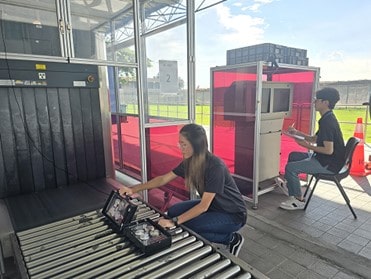HTX’s CBRNE CoE has collaborated with Synergy4Tech to design X-ray machine test pieces

Synergy4Tech’s XTE Check test pieces. (Photo: Synergy4Tech)
By Jacquelynn Thangavelu
Just like how optometrists use eye test charts to check our vision, border security officers also have special tools that can be used to test the vision of X-ray machines.
Why is this important? Because X-ray machines play a critical role in preventing threats like improvised explosive devices (IEDs) and illegal goods from slipping past our borders.
To help the Immigration and Checkpoints Authority (ICA) perform “vision checks” on their machines, HTX has been working closely with a local company called Synergy4Tech to improve the test pieces.
Cheung Ka Kei, Lead Engineer (Threat Scanning Technology and Analytics) at the HTX’s CBRNE (Chemical, Biological, Radiological, Nuclear and Explosives) CoE (Centre of Expertise), shared that the collaboration between the two teams has been taking place since 2022 and involves assessing the imaging performance of X-ray machines used at the borders.
According to Ka Kei, these test pieces help evaluate an X-ray machine’s ability to distinguish subtle differences in shades of colours. This colour distinction is crucial, he added, as threats like explosive powder can often resemble everyday items, like flour or sugar.
Additionally, the CBRNE team uses Synergy4Tech’s XTE Check test pieces for X-ray penetration and wire resolution tests. While the X-ray penetration test determines how deep X-rays can penetrate concealment, wire resolution tests provide an indicator of how well wires can be visualised in the X-ray images presented to image analysts.
“We've been using these machine-agnostic X-ray test pieces to monitor performance across various X-ray machines—ranging from small baggage X-ray machines to large vehicle portals for screening containers. We've also identified areas of improvement and are co-designing better test pieces with them,” said Ka Kei.
 Ka Kei and Gina Leow (CBRNE Engineer) putting the XTE-Check through an X-ray machine. (Photo: HTX)
Ka Kei and Gina Leow (CBRNE Engineer) putting the XTE-Check through an X-ray machine. (Photo: HTX) “In previous iterations of the penetration test, the test piece for small tunnel machines was designed so that a single circular lead block was placed behind steel slices of varying thickness. The idea was that if an X-ray beam was too weak, it wouldn’t be able to penetrate thicker steel slices and “see” the lead block. However, the test piece’s configuration made it difficult for image analysts to clearly distinguish which steel piece had blocked the X-ray beam.”
To resolve this problem, the CBRNE team proposed a new design for the penetration test —rather than having a single lead block, the test pieces would contain multiple smaller lead blocks, with each of them being positioned behind different steel slices.
Under this new configuration, the results would be more distinct and definite decisions can be made regarding the X-ray’s penetrability.
The team also suggested enlarging the test piece to incorporate more American Wire Gauge (AWG) wires, thus allowing for a greater variety of wire resolutions to be checked. This enhancement is critical as different sorts of wires are commonly used in improvised explosive devices.
Improving upon improvements
After improvements were made to the penetration and wire resolution tests for the XTE-Check test piece, the CBRNE team requested an additional test to check for detonators. Aptly named the “detonator test”, this test allows image analysts to detect detonators by identifying their cross section on X-ray images.
“Initially, the test piece had only a small circular cross section, which didn't mimic a detonator’s cross section. We asked Synergy4Tech to modify the design to include a cylindrical cross section; we hope to go through more iterations to customise the test pieces and get the most value from them,” Ka Kei shared.
Looking ahead, the CBRNE team envisages that such test pieces can provide a set of “health indicators” to all the X-ray scanning systems at the borders regularly and that the results can be centrally monitored through a network. This would ensure that any sub-optimal system can be attended to and rectified promptly.
This development would also benefit other security agencies by providing them with independent tools to ensure their X-ray machines meet the necessary standards and are capable of effectively intercepting threats.